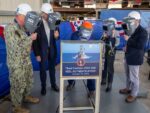North Korea announced the successful test of a new surface-to-air missile (SAM) system on April 1st, 2024. The test was reportedly overseen by leader Kim Jong Un and is part of Pyongyang’s broader effort to modernize its air defense capabilities amid growing regional tensions. While details remain limited and unverifiable from independent sources, the announcement comes as the U.S., South Korea, and Japan expand trilateral security cooperation in Northeast Asia.
New SAM System Claimed to Be “Key to National Defense”
According to North Korean state media (KCNA), the newly tested SAM system is designed to enhance the country’s layered air defense network. The system was described as a “new-type anti-aircraft missile weapon,” and its development is reportedly aimed at countering advanced aerial threats including cruise missiles and stealth aircraft.
The test involved both detection and interception trials. Although no specific designation or technical specifications were provided by North Korean sources, KCNA emphasized that the system demonstrated “remarkable performance” in terms of guidance accuracy and target engagement. Kim Jong Un was quoted as saying the development represents a “core task” in strengthening national defense capabilities.
This aligns with previous trends in North Korean military modernization efforts that have focused not only on offensive systems like ballistic missiles but also on defensive assets such as radar networks and interceptors.
Possible Successor or Variant of KN-06?
Observers speculate that the newly tested system may be an evolution of the KN-06 (also known as Pon’gae-5), North Korea’s long-range SAM first unveiled in 2010 and tested multiple times since. The KN-06 bears visual similarities to Russia’s S-300 series and reportedly has an estimated range of 100–150 km with radar-guided missiles.
Satellite imagery analysis from previous parades has shown transporter erector launchers (TELs) carrying large canisters consistent with long-range SAMs. However, recent developments suggest Pyongyang may be working toward more mobile and survivable platforms with improved radar integration—possibly incorporating phased-array radars or dual-mode seekers for better resistance against jamming.
If this new SAM incorporates such features—especially multi-target tracking or low-altitude interception—it would mark a significant leap from earlier systems that relied heavily on legacy Soviet-era designs.
Strategic Implications for Regional Air Superiority
The timing of this announcement is significant. It coincides with expanded joint exercises between U.S. Pacific Air Forces (PACAF) and South Korean forces under Exercise Freedom Shield 2024. These drills include fifth-generation fighters like F-35As conducting simulated deep strike missions—precisely the type of threat North Korea’s air defenses would seek to counter.
A more capable North Korean SAM network could complicate allied air operations over or near DPRK territory by increasing risk to ISR platforms (e.g., RQ-4 Global Hawk), electronic warfare aircraft (e.g., EA-18G Growler), or even strategic bombers operating at standoff ranges. While it is unlikely that any current DPRK system could reliably engage stealth aircraft like the F-22 or B-2 Spirit at long range, improved radar coverage could still degrade freedom of maneuver for support assets operating near contested zones.
This also raises questions about how North Korea prioritizes its limited resources between strategic deterrence (i.e., nuclear-capable ballistic missiles) versus conventional force modernization such as integrated air defense systems (IADS).
No Independent Verification Yet
As with most DPRK weapons claims, independent verification remains elusive. No video footage or telemetry data has been released publicly to confirm performance metrics such as range, altitude ceiling, seeker type, or success rate against live targets.
South Korean officials acknowledged awareness of recent missile activity but declined to confirm whether it involved a new SAM platform specifically. The U.S. Indo-Pacific Command issued no formal statement regarding this particular launch but continues monitoring regional developments closely through space-based ISR assets and allied intelligence sharing mechanisms.
Given Pyongyang’s history of exaggerating test results for propaganda purposes—as seen with past submarine-launched ballistic missile (SLBM) tests—the actual operational maturity of this new air defense asset remains uncertain.
DPRK Air Defense Modernization Trajectory
This latest announcement fits into a broader pattern observed over the past five years where North Korea has sought to improve its IADS architecture through both indigenous development and adaptation of foreign technologies:
- Radar Systems: Reports suggest increased deployment of mobile 3D surveillance radars across mountainous terrain to improve early warning coverage.
- SAM Integration: Potential efforts underway to network older SA-series systems with newer command-and-control nodes using fiber-optic links or encrypted RF comms.
- Tactical Mobility: Emphasis on road-mobile TELs for both offensive missiles and defensive interceptors enhances survivability against preemptive strikes.
If sustained over time despite sanctions pressure, these improvements could gradually shift North Korea from a static point-defense model toward a more dynamic IADS posture capable of area denial within certain engagement envelopes—particularly around key regime centers like Pyongyang or Wonsan.
Conclusion: A Cautious Watch on Capabilities vs Claims
The claimed test underscores Pyongyang’s intent to bolster multi-domain deterrence—not only through nuclear delivery systems but also via conventional military modernization aimed at denying adversary advantages in ISR and precision strike domains. However, without verifiable data or imagery confirming performance characteristics or deployment scale, analysts remain cautious about assigning high confidence levels to these claims.
If proven credible through future testing cycles or satellite observations indicating serial production/deployment patterns, this new SAM system could represent a meaningful step forward in DPRK’s layered air defense strategy—a development likely monitored closely by Seoul, Tokyo, and Washington alike.










